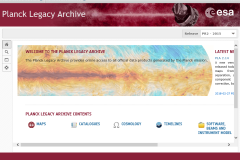Planetek Hellas has successfully delivered to the European Space Agency (ESA) the Planck Legacy Archive Added-Value Interface (PLAAVI). The PLAAVI consists of a set of added-value web tools that permit scientists to perform remote processing on the Planck products, which reside physically in the online ESA archive hosted at the European Space Astronomy Centre (ESAC), in Madrid.
The scientific community around the world can now perform additional remote processing on products in the Planck archive, something that is expected to increase significantly the uptake of the data and the impact of the mission.
The PLAAVI has been seamlessly integrated with the main web platform of the Planck Legacy Archive (PLA), ensuring its maximum exploitation by the astronomical scientific community, with the minimum “get to know” effort.
Jan Tauber, ESA’s Planck Project Scientist said: “The functionality provided by PLAAVI will help scientists who are not very familiar with details of the Planck data to use it in their astrophysical analysis. I am very happy to be able to offer this facility, and I expect an enhanced utilization of our Archive will result from it”.
For this successful delivery, Planetek Hellas collaborated with Planck scientists from the Institute of Theoretical Astrophysics of the University of Oslo, Norway, who participated in the team through Expert Analytics (XAL), a spinoff company of the SIMULA Research Center.
Stelios Bollanos, Director and Co-founder of Planetek Hellas said: “This delivery is an excellent example of our ability to understand well the needs of the space scientific community and provide robust industrial software engineering services in support of ESA’s activities for Mandatory Programs”.
The PLAAVI web tools permit to perform processes on the Planck products such as: component subtraction, unit conversion, colour correction, bandpass transformation, masking of map-cutouts or full-sky maps, component separation, map-making using two different types of time-ordered data, effective beam averaging and noise map cutout.
The PLAAVI functionality can be accessed via the main Planck Legacy Archive (PLA) website. For more technical information please consult the dedicated documentation.
About the Planck Mission
The Planck satellite, during its operational period from 2009 to 2013, orbited the Earth near the Lagrange 2 point, 1.5 Million km from Earth. Its main objective was to measure the fluctuations of the Cosmic Microwave Background – the most ancient light in the history of the Universe – with an accuracy set by fundamental astrophysical limits, charting the most accurate maps to date. The Planck maps are used today by scientists and will be used in the future by the generations of scientists to come, in order to analyze and compare theories of the birth of the universe and bring us closer to answering the fundamental question “How did everything start?”.




